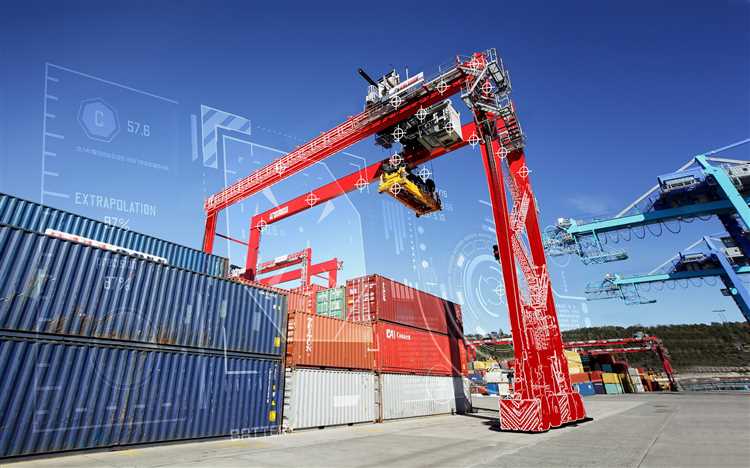Rubber Tyred Gantry (RTG)
A rubber-tired gantry (RTG) crane is a type of mobile crane that is commonly used in container terminals for stacking and moving shipping containers . RTGs are designed with rubber tires that provide flexibility and maneuverability on different surfaces .
Key Features of RTGs
RTGs have several key features that make them an efficient choice for container handling operations. These include:
- Rubber Tires: The rubber tires on RTGs allow for flexibility and maneuverability, making them suitable for use on different types of surfaces , such as concrete, asphalt, and gravel.
- Stacking Height: RTGs can stack containers to a height of up to 1 over 1, meaning they can stack containers on top of each other up to one over one.
- Slewing: RTGs are capable of slewing, which means they can rotate or swivel horizontally. This feature allows them to reach containers located in different positions.
- Spanning: RTGs have the ability to span multiple container rows, which allows them to handle multiple containers at once.
- Electrification: Some RTGs are equipped with electric power systems , which reduce emissions and make them more environmentally friendly.
Advantages of RTGs
RTGs offer several advantages over other types of cranes for container handling operations. These advantages include:
| Advantage | Explanation |
|---|---|
| Flexibility | RTGs can easily maneuver on different surfaces , allowing for increased flexibility in container handling operations. |
| Efficiency | RTGs are designed to stack and move containers quickly and efficiently , reducing handling time and increasing productivity. |
| Scalability | RTGs can be easily scaled up or down depending on the size and volume of container operations. |
| Environmentally Friendly | RTGs equipped with electric power systems produce fewer emissions compared to other types of cranes . |
Conclusion
Rubber-tired gantry cranes (RTGs) are a popular choice for container handling operations in container terminals. With their rubber tires, RTGs offer flexibility and maneuverability on different surfaces , making them efficient and versatile. Their key features, such as stacking height, slewing, spanning, and electrification, make them a reliable option for stacking and moving shipping containers . Additionally, RTGs provide several advantages over other types of cranes , including increased flexibility , efficiency, scalability, and environmental friendliness.
Rubber Tyred Gantry (RTG)

A rubber tyred gantry crane (RTG) is an industrial crane used in shipyards and intermodal facilities for container handling. It has rubber tyred wheels and travels on paved surfaces, making it highly productive in various logistic operations and extensive in its applications to meet customer demand.
The primary function of an RTG is to lift and move shipping containers efficiently. Its wheeled design allows for easy mobility, and the hoisting and gantry system enables precise stacking of containers in terminals or yards with available options for anti-sway features to ensure stability. Additionally, the crane with a special configuration can be equipped with cable reels for efficient power connection and energy management.
The use of rubber tyred wheels makes the RTG a cost-effective solution compared to other loading and unloading cranes. The tires provide better traction and reduce the risk of damage to containers and the ground, minimizing maintenance costs. Options for diesel or electric engine configurations are also available, depending on the condition of the terminal environment.
With liftable and adjustable axles, an RTG can be positioned optimally for container stowage and shipment. It can also be equipped with an automated control system for precise positioning and alignment of containers during loading and unloading, ensuring all rights reserved for operator safety standards. In some cases, the simulator provides real-time feedback for development and maintenance needs, enhancing the overall technology used in crane operations.
The RTG plays a crucial role in intermodal transport and logistics, including delivery solutions. It transfers containers between different modes of transportation, such as trucks, trailers, or rail cars, facilitating the smooth flow of goods in both national and international supply chains. It’s also available with various configurations, including straddle carriers and mobile gantry cranes setups, which are essential for efficient inspection processes.
Overall, the rubber tyred gantry crane (RTG) is an essential machine in construction, shipping, and logistics industries. Its capability to handle heavy loads, navigate on different surfaces, provide cost-effective terminalization ensures smooth and efficient operations in the global supply chain, supporting careers in logistics and enhancing connections across supply routes, including China and beyond.
For additional specifications or to create a custom configuration with our company, visit our downloads section or email us for further assistance regarding software integration for your forklift operations, including specialized options like trolley systems for enhanced mobility.
Video:
